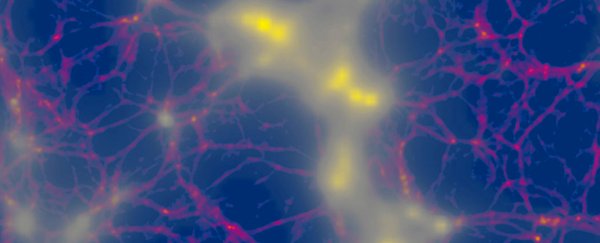What's the mass of a neutrino? This problem has vexed physicists for decades. It's tiny, no doubt, but by virtue of one of the particle's most fundamental features, it can't be zero. This still leaves plenty of room for guesswork.
Like most riddles, the solution might be found by thinking outside of the box.
Physicists from the University of Tsukuba, Kyoto University, and the University of Tokyo in Japan have taken this advice to heart, using a revolutionary new method for modeling a significant chunk of the Universe to act as a testing ground for the subtle influence of neutrinos on the evolution of the cosmos.
It's an idea that's been tested before. But by applying a simulation used in other areas of physics, the researchers behind this new model think they can iron out some of the previous method's shortcomings.
Neutrinos have been a theoretical part of the standard model of physics since 1930, and a confirmed member since their experimental discovery in the mid-1950s.
Technically, this ghost-like particle should be as massless as a photon. But a little over twenty years ago scientists worked out that not only do they come in a variety of forms, or 'flavors', they oscillate between them as they move.
For this very reason, physicists are confident neutrinos must have some kind of mass. Even if it's a whisker off nothing. If neutrinos didn't have mass, they would move at the speed of light in a vacuum, and if that was the case, time would stand still for them, so they wouldn't be changing at all.
Searches for a precise mass using laboratory methods have put upper limits on how chunky a neutrino could potentially get, capping it at 1/500,000 of a single electron. So, it's safe to say that somewhere between zip and 1/500,000th of an electron's mass, we have our answer.
This new method might just bring us a little closer to that number, though admittedly, reconstructing most of a Universe to weigh something that barely exists isn't without its irony.
Fortunately, what the humble neutrino lacks in punch it makes up for in sheer numbers.
From the very earliest moments in time, neutrinos have been a part of the Universe in significant amounts, churned out of the roiling vacuum itself within the first second of the Big Bang.
Just like the static hum of leftover radiation we still see as a cosmic microwave background, a neutrally-charged background of these neutrino relics surround us to this day.
There's little doubt that masses of relic neutrinos would have had some kind of influence on the emerging structures of the Universe. Precisely what kind of effect isn't so easy to figure out.
In a typical physics model of something like a solar system, or even a bunch of atoms, you might select a number of objects, define their behaviors with respect to one another, map them in 3D space, and let a computer calculate what happens over time.
Want more objects? Get a faster computer and add them in.
Such 'N-body' simulations can work well for large-scale simulations. But they have their limits, especially when rubbed up against physics of a more quantum nature.
Quantum objects like massive neutrinos don't play by the same rules as classical particles. Neutrinos are only known to interact with gravity and weak subatomic forces, so it's hard to say how different types of neutrinos stirred up the early Universe.
In this new model, the researchers borrowed an equation from plasma physics called a Vlasov simulation. Rather than treat relic neutrinos as discrete classical objects, the plasma-based equations allowed the team to describe them as if they were a continuous medium.
Running the simulation on a supercomputer at RIKEN Center for Computational Sciences in Japan demonstrated that the program could be used on a range of scales, resulting in fairly accurate representations of the structure of most of the observable Universe.
"Our largest simulation self-consistently combines the Vlasov simulation on 400 trillion grids with 330 billion-body calculations, and it accurately reproduces the complex dynamics of cosmic neutrinos," says lead author of the study, physicist Koji Yoshikawa from the University of Tokyo.
Future work will be needed to tweak the details to hopefully zoom in on a more precise figure for the relic neutrino's mass. Yet it's an innovation that has already earned the team recognition in the form of a finalist's place in the 2021 ACM Gordon Bell Prize.
Their revolutionary new way of modeling large-scale structures this way isn't just a potential win for physicists eager to learn precisely how much mass a neutrino commands, either; it could have applications in plasma physics as well.
This research was published in SC '21: Proceedings of the International Conference for High Performance Computing, Networking, Storage and Analysis.
